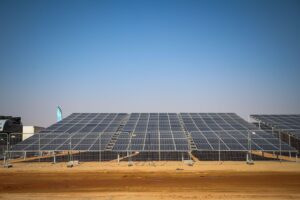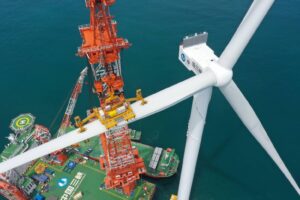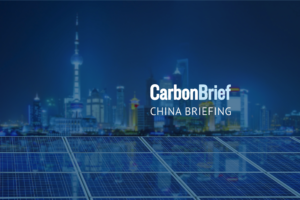For the first time, the growth in China’s clean power generation has caused the nation’s carbon dioxide (CO2) emissions to fall despite rapid power demand growth.
The new analysis for Carbon Brief shows that China’s emissions were down 1.6% year-on-year in the first quarter of 2025 and by 1% in the latest 12 months.
Electricity supply from new wind, solar and nuclear capacity was enough to cut coal-power output even as demand surged, whereas previous falls were due to weak growth.
The analysis, based on official figures and commercial data, shows that China’s CO2 emissions have now been stable, or falling, for more than a year.
However, they remain only 1% below the latest peak, implying that any short-term jump could cause China’s CO2 emissions to rise to a new record.
Other key findings include:
- Growth in clean power generation has now overtaken the current and long-term average growth in electricity demand, pushing down fossil fuel use.
- Power-sector emissions fell 2% year-on-year in the 12 months to March 2025.
- If this pattern is sustained, then it would herald a peak and sustained decline in China’s power-sector emissions.
- The trade “war” initiated by US president Donald Trump has prompted renewed efforts to shift China’s economy towards domestic consumption, rather than exports.
- A new pricing policy for renewables has caused a rush to install before it takes effect.
- There is a growing gap that would need to be bridged if China is to meet the 2030 emissions targets it pledged under the Paris Agreement.
If sustained, the drop in power-sector CO2 as a result of clean-energy growth could presage the sort of structural decline in emissions anticipated in previous analysis for Carbon Brief.
The trend of falling power-sector emissions is likely to continue in 2025.
However, the outlook beyond that depends strongly on the clean energy and emissions targets set in China’s next five-year plan, due to be published next year, as well as the economic policy response to the Trump administration’s hostile trade policy.
China’s emissions decline due to clean power
Over the past decade, China’s CO2 emissions from fossil fuels and cement have risen by nearly a fifth, but there have been ups and downs along the way.
The shallow decline in 2015 and 2016 was due to a slump that followed a round of stimulus measures, while zero-Covid controls caused a sharper fall in 2022. Overall, however, emissions have continued to increase, pausing only during periods of economic stress.
More recently, there have been signs that China’s CO2 emissions could be close to reaching a peak and plateau, or even a period of structural decline.
The latest data, for the first quarter of 2025, shows that China’s CO2 emissions have now been stable or falling for more than a year, as shown in the figure below.
However, with emissions remaining just 1% below the recent peak, it remains possible that they could jump once again to a new record high.
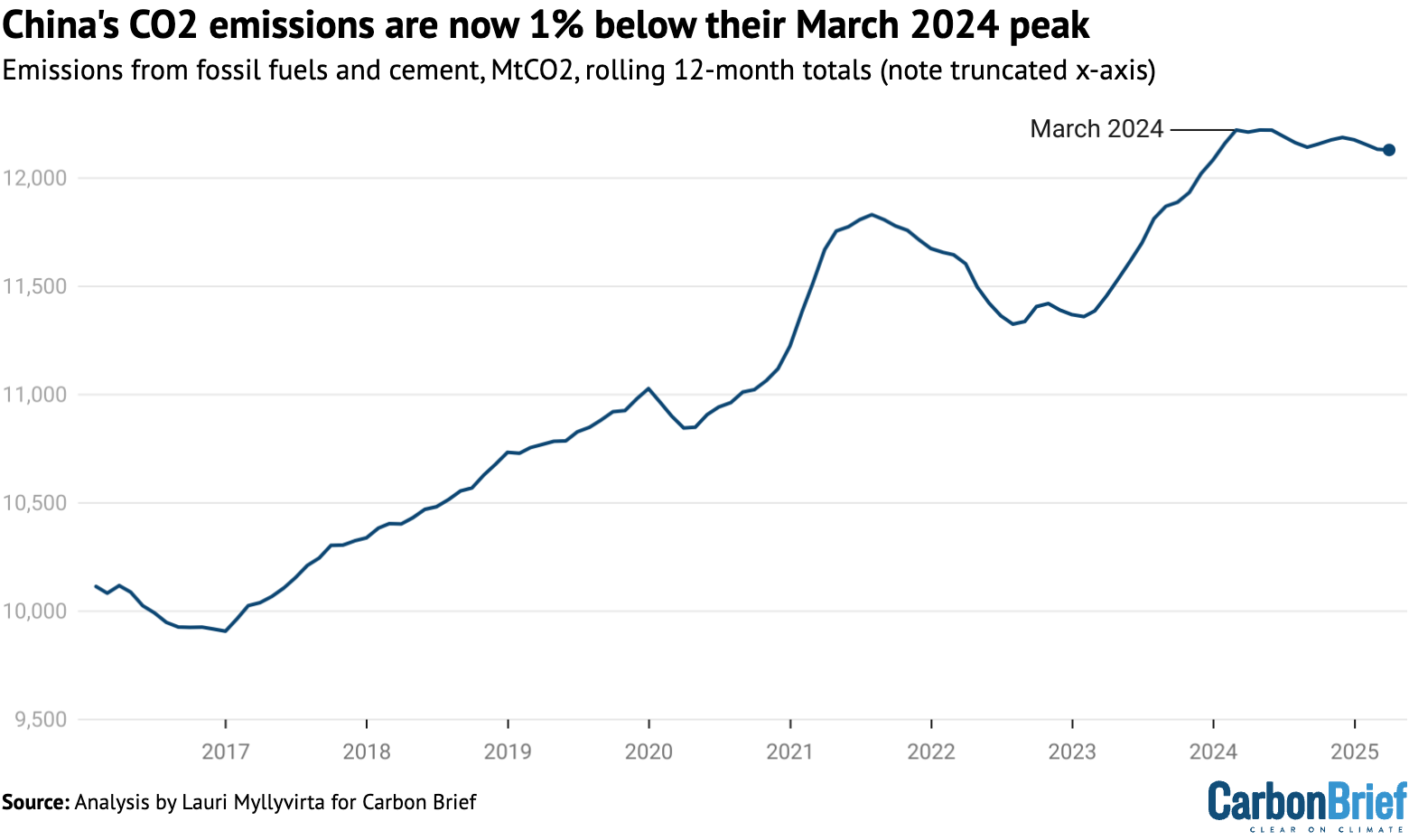
Therefore, the future path of China’s CO2 emissions hangs in the balance, depending on trends within each sector of its economy, as well as China’s response to Trump’s tariffs.
These sectoral trends are explored further in the sections below, along with signals on what could be coming next from Chinese policymakers as they consider the country’s international climate pledge for 2035 and the five-year plan for 2026-2030.
Power-sector emissions fall while other sectors rebound
The reduction in China’s first-quarter CO2 emissions in 2025 was due to a 5.8% drop in the power sector. While power demand grew by 2.5% overall, there was a 4.7% drop in thermal power generation – mainly coal and gas.
Increases in solar, wind and nuclear power generation, driven by investments in new generating capacity, more than covered the growth in demand. The increase in hydropower, which is more related to seasonal variation, helped push down fossil power generation.
Power-sector emissions fell by more than total generation from fossil fuels, as the share of biomass and gas increased, while average coal power plant efficiency improved.
Specifically, the average amount of coal needed to generate each unit of electricity at coal-fired power plants fell by 0.9% year-on-year.
The first-quarter reduction in CO2 emissions from coal use in the power sector is shown at the bottom of the figure below, below CO2 changes in other sectors.

Outside of the power sector, emissions increased 3.5%, with the largest rises in the use of coal in the metals and chemicals industries.
The coal-to-chemicals industry is undergoing rapid expansion, driven by concerns about dependence on imported oil and gas. During the first quarter of 2025, it was also benefiting from more favourable economics due to lower coal prices and relatively high oil prices.
Crude steel production increased 0.6% year-on-year, metal products output by 6% and non-ferrous metals production by 2%. All of these increases were mainly due to a jump in March. Metals demand was boosted by the bump in exports ahead of the tariffs, but high output has continued well into April.
Real-estate construction “starts” fell by 24% and sales of new properties by 3%, indicating that the demand for cement, steel and glass from the construction sector continues to decline.
In contrast, economic output in vehicle and machinery production increased by 12% and 13%, respectively, signalling increased demand for metals.
Cement production fell by 1.4%, a slower rate of decrease than in previous years, likely due to an earlier start to weather-dependent construction activity thanks to warm weather.
Gas consumption increased by an estimated 6% in the power sector, due to a 14% increase in gas-fired power generation capacity, even as the average utilisation of the plants fell. However, gas consumption fell in other sectors, outweighing the increase for power.
Oil products consumption increased slightly, as shown by the bar at the top in the figure above. Warmer weather meant that weather-dependent construction and agricultural activity rose earlier in the year than usual.
However, structural factors, particularly vehicle electrification and the shift to liquified natural gas (LNG) in the freight sector, point to continued declines in oil demand.
Have China’s emissions peaked?
Following the 1.6% decline in the first quarter of 2025, China’s emissions have now been stable or falling for more than a year, starting from the beginning of March 2024.
However, emissions in the 12 months to the end of March 2025 were down only 1% from their recent peak, implying that any short-term jump could lead to a new record high.
After the sharp reduction in the first quarter, emissions from power generation are now down year-on-year for the most recent 12 months.
This has happened four times before over the past four decades – in 2009, 2012, 2015 and 2022. However, the current drop is the first time that the main driver is growth in clean power generation.
The falls in 2009 and 2012 were related to the global financial crisis and the Euro area crisis, while the drop in 2015 was driven by the construction and industrial sector slump that followed the 2008-12 stimulus program.
These economic shocks resulted in the sharp reduction in electricity demand shown in the figure below. The drop in 2022 was a combination of slow power demand growth due to strict “zero-Covid” measures and relatively strong clean-power additions.
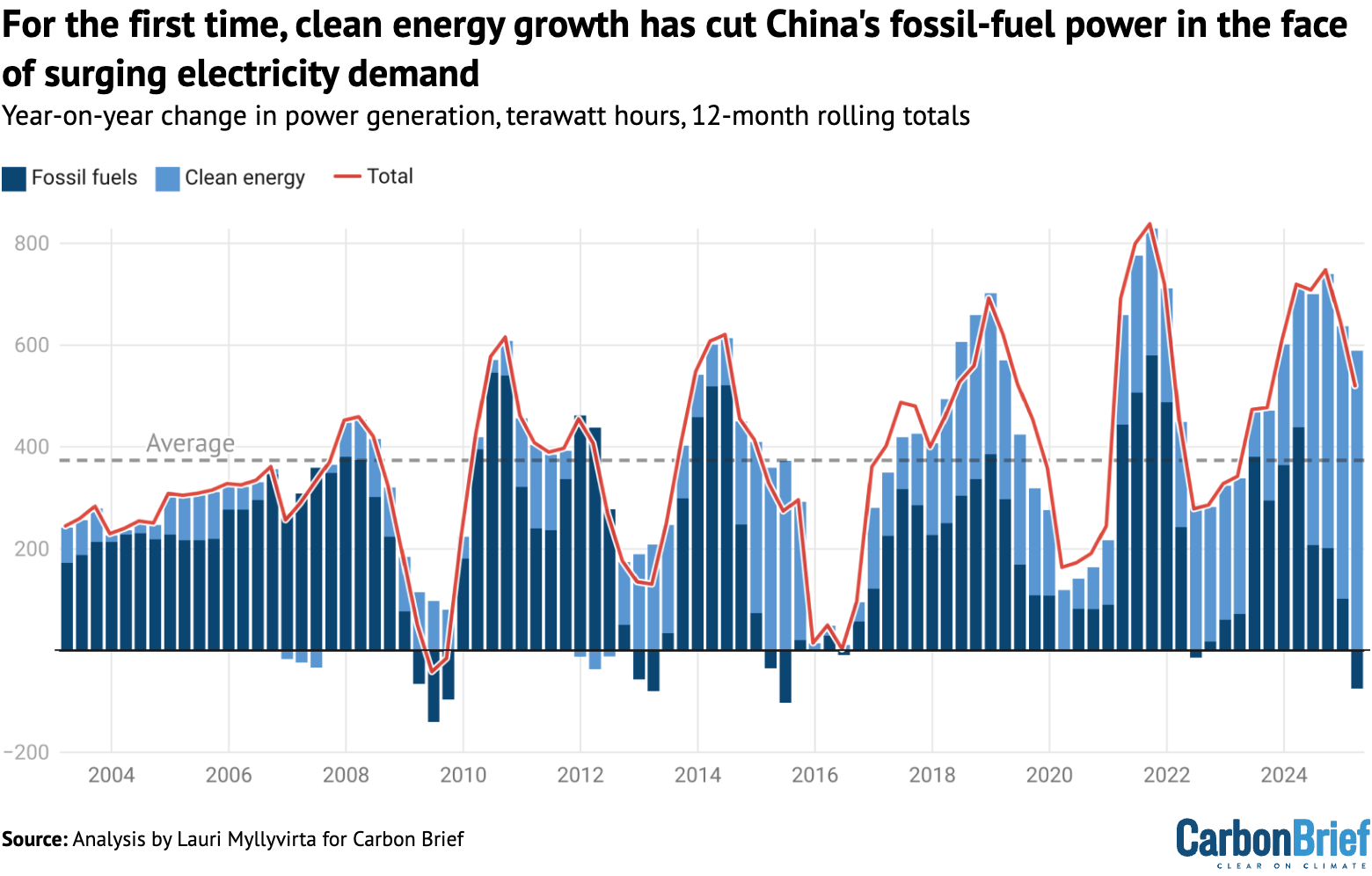
Importantly, the growth in clean power generation in the first quarter of 2025 was not only larger than the rise in demand overall, it was also higher than the average increase in demand over the past 15 years, marked by the dashed line in the figure above.
Moreover, hydropower has been stable year-on-year in the past six months, implying that the clean-energy growth has been driven by increases in solar, wind and nuclear power capacity, not year-to-year variation in hydropower output.
Looking beyond electricity generation, all sectors registered a fall in emissions over the most recent four months from December 2024 to March 2025, except for coal-to-chemicals.
In order for China’s emissions overall to peak and then start declining, CO2 cuts in declining sectors will need to outweigh continued growth elsewhere.
For example, process emissions from cement production peaked in 2021 and have declined by 27% since then, as shown in the top left chart in the figure below.
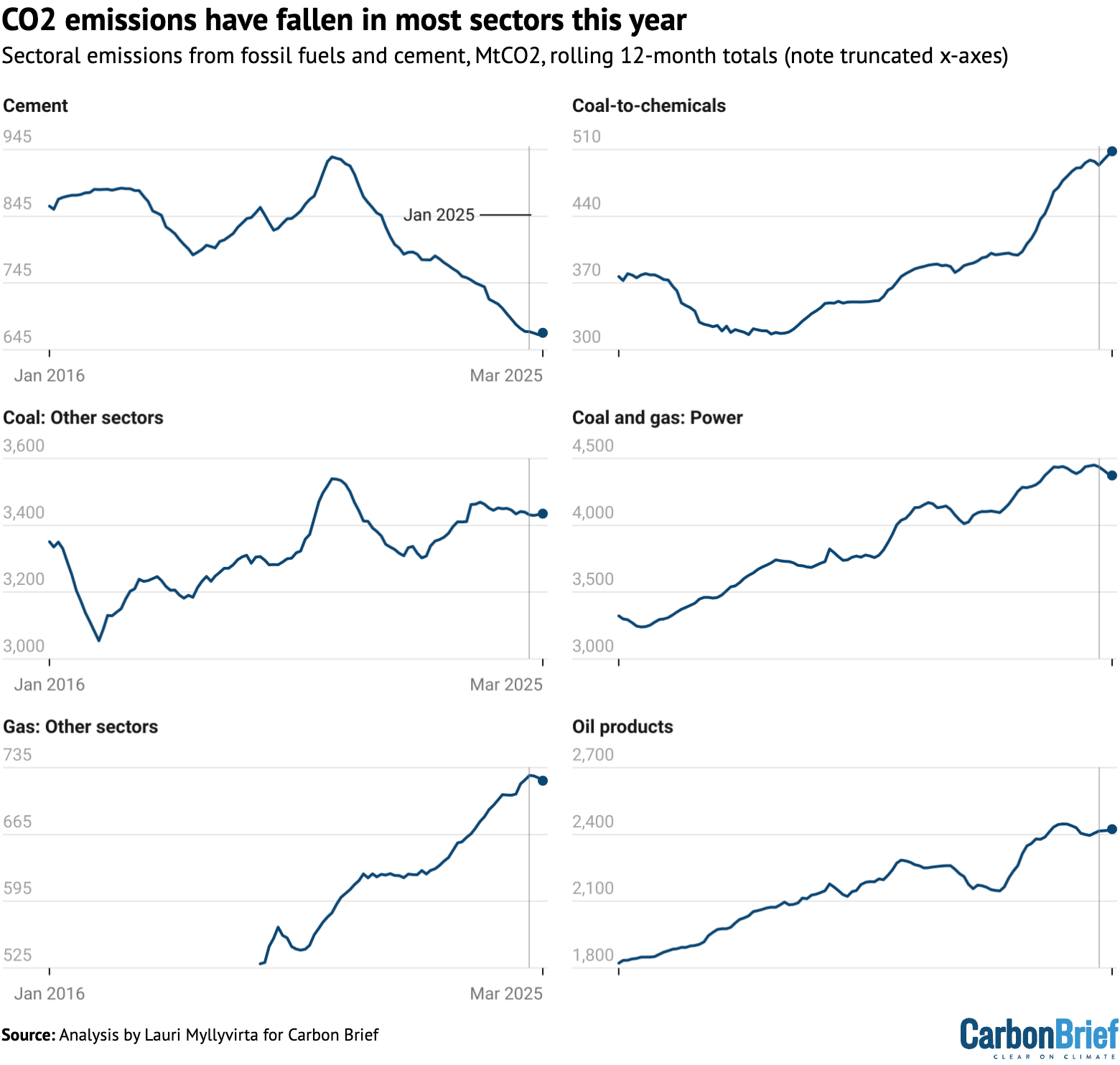
Coal use outside the power and chemicals sectors peaked at the same time as cement, but has been rebounding since then and is now close to previous peak levels.
The China Coal Association expects coal use in the steel and building materials industries to fall, while coal consumption in the chemical industry is projected to continue growing.
Hopes of future growth in demand for coal are pinned on the chemical sector, described as a shift from using coal primarily as a fuel to a role as both a fuel and a raw material.
The association also believes that coal-fired power generation will resume growth – at least in the short term – but it recently revised down its projections for 2025 compared with the outlook at the end of 2024.
The tariff “war” may have affected expectations. One analysis suggests a 0.5 to 1 percentage point reduction in China’s GDP growth rate due to the tariffs could result in a similar reduction in demand for thermal coal – mainly used at power stations.
Oil product consumption has been declining since the post-Covid rebound ended in March 2024, falling 2% from its peak. The long-term trend is expected to be downwards, due to the electrification of transportation, despite rising demand for chemicals and aviation.
Gas use has been falling for a few months, but the trend is likely still increasing.
The table below lists the 12-month periods with the highest emissions for each sector, as well as the reduction since the latest peak in each case.
| Sector | Date of highest emissions | Reduction since peak |
|---|---|---|
| Cement | April 2021 | -28.2% |
| Coal and gas: Power | November 2024 | -1.7% |
| Coal-to-chemicals | March 2025 | Still increasing |
| Coal: Other sectors | April 2021 | -3.0% |
| Gas: Other sectors | December 2024 | -0.8% |
| Oil products | April 2024 | -1.0% |
| Total CO2 | February 2024 | -0.8% |
For all of the sectors other than cement production, it is too early to declare a definitive peak in emissions. Still, there are signs that other sectoral peaks could be past their peak, too.
Indeed, for oil products consumption and steel production, industry projections indicate that the future trend is likely to be falling.
For the power sector, clean-energy additions at or above current levels would likely lead to a structural peak, as clean-energy growth would more than cover electricity demand growth.
Together, these sectors cover more than 80% of China’s total emissions. If all of them enter a structural decline, then total emissions are very likely to do so too.
China pushes domestic demand in response to US tariffs
The economic and emissions outlook for this year and beyond will be affected by the Trump administration’s unprecedented trade tariffs – and China’s counter-measures.
The initial impact was a drop in emissions due to lower factory output in export-oriented coastal provinces and possible knock-on impacts on investment and consumer spending.
Conversely, the temporary easing of tariffs for 90 days will lead to a rush of orders from the US to make up for the short-lived slowdown in trade and to stockpile goods before the relief ends.
China’s reactions to the tariffs focused on counteracting the economic impacts with stimulus.
An anonymous comment piece in People’s Daily, the main Communist party affiliated newspaper, says the country should “strive to make consumption the main driving force and ballast stone of economic growth”, leveraging China’s large domestic market.
(The piece has the byline “People’s Daily commentator”, which implies that it is written by someone with authority.)
The article says that this will involve increasing consumer income, while easing financial and social burdens to boost purchasing power and willingness to consume.
While the temporary easing of tariffs will reduce the urgency of these measures, the US tariff rate on China, at 40%, remains much higher than it was before Trump’s presidency – and China’s leaders will likely want to prepare against the risk of renewed tariff hikes.
The focus will be creating domestic markets for the products China exports to the US. The long-held aim of rebalancing China’s economy towards consumption could finally become reality as a result. A successful rebalancing could mean less energy-intensive growth.
China’s response also includes redoubling its focus on “new quality productive forces”, a concept that emphasises new technology.
The concept includes the clean-energy industry, which has become such an important economic driver in China that it would be hard to leave out of stimulus plans.
A new list of low-carbon demonstration projects, published by the National Development and Reform Commission, provides a look at China’s priorities for clean-energy investment. Green hydrogen, energy storage, “virtual power plants” and industrial decarbonisation based on hydrogen are new growth areas.
In terms of the emissions implications of China’s response to Trump’s tariffs, the big question is whether stimulus focused at these favoured sectors – including the new low-carbon focus areas and other clean-energy industries – is deemed sufficient.
Some traditional recipients of stimulus spending, such as shipbuilding and public infrastructure, have already posted strong growth in the first quarter of this year as a result of stimulus measures announced in 2024.
New wind and solar pricing policy increases uncertainty
An additional source of uncertainty for China’s emissions comes in the form of its new electricity pricing policy for renewable energy, which enters into force in June.
The new policy removes price guarantees pegged to coal-power prices, with new wind and solar projects supposed to secure direct contracts with electricity buyers. This is likely to lead to lower prices being paid to new wind and solar projects.
However, it offers more favourable pricing – via “contracts for difference” – to the amount of new capacity needed to meet central government energy targets.
The immediate effect of the policy will likely be a rush of projects rushing to complete installation before the June deadline, so as to secure guaranteed prices.
This rush was already apparent in the latest data: 23 gigawatts (GW) of solar and 13GW of wind was added in March alone, up 80% and 110% from previous records for the month.
Furthermore, this year’s installations are likely to be very strong, even topping last year’s record, as a lot of centralised solar power and wind-power projects are racing to complete before the end of the 14th five-year plan period.
The China Wind Energy Association expects a new record of 105-115GW installed this year across onshore and offshore wind projects – up from the record-breaking 80GW last year – based on very active bidding last year. It also expects volumes to stay at that level even in 2026 and to then grow further towards 2030.
The China Electricity Council predicts an even larger wind-power capacity addition of 120GW in 2025. Another analyst projects a 20% drop in wind-power capacity additions in 2026, but after an even steeper increase in 2025 to 120-130GW of capacity added. So he also expects 2026 installations to be far above the current record year of 2024.
For solar, the China Photovoltaic Industry Association forecasts a drop in installations of 8-23% this year, from the staggering record of 278GW last year. Even the low end of this projection would see installations stay at 2023 levels in 2025 and then recover from there. The China Electricity Council’s projection for solar additions in 2025 matches the low end of the industry association’s forecast.
The figure below, based on these various projections, shows that additional electricity generation from new clean power capacity is expected to remain above last year’s record-breaking levels in both 2025 and 2026.
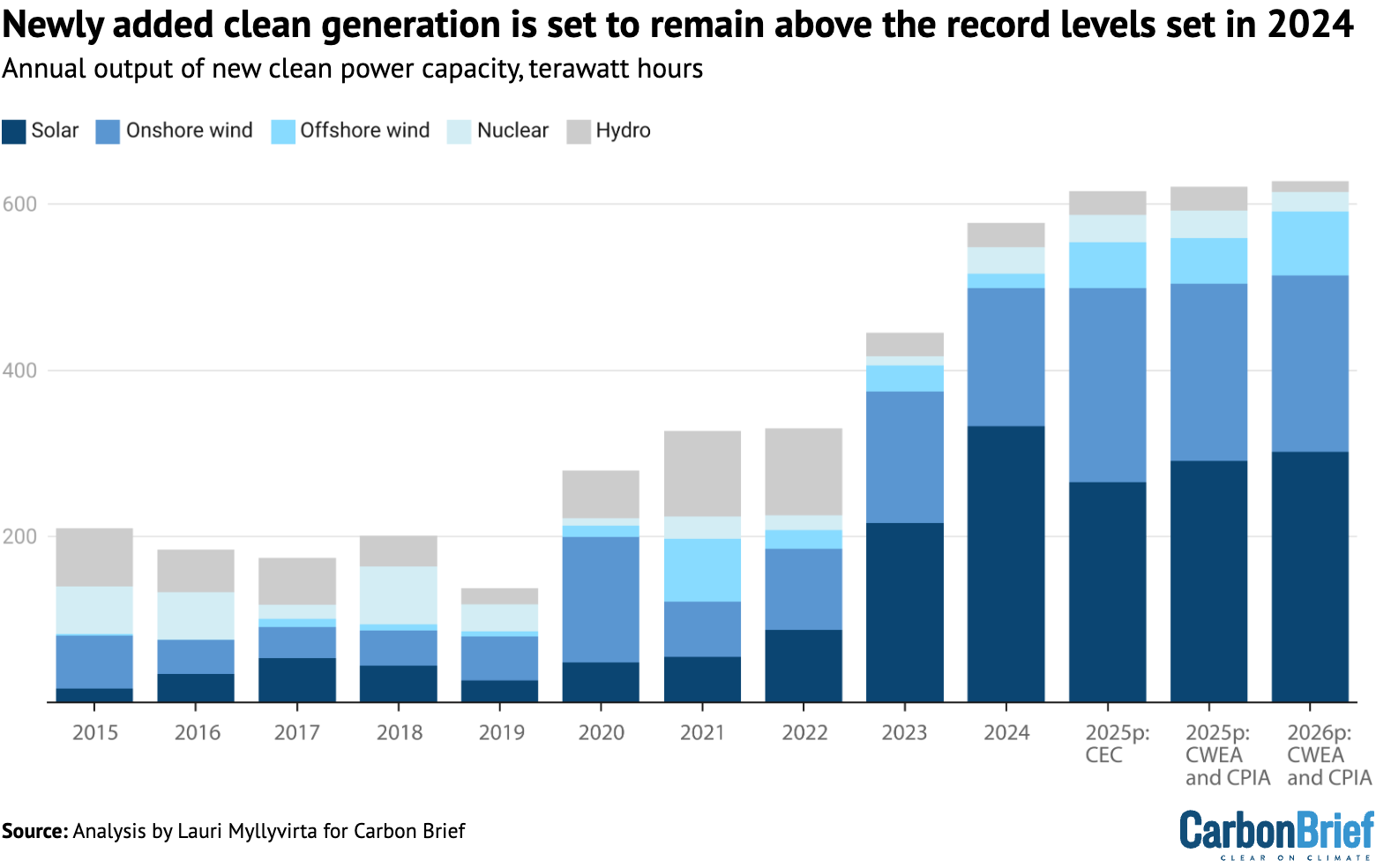
The projections shown in the figure above illustrate that the energy industry expects to be able to navigate the new renewable pricing policy and to maintain a high level of wind and solar additions over the next two years.
The policy has, however, created a lot more uncertainty. The stop-go cycle of a flood of installations in the first half of this year and then a slowdown in the second half – likely especially in the distributed solar segment – is likely to be a tough time for the industry.
The uncertainty relates above all to two things. First is the local implementation of the policy, as provincial governments have a lot of leeway here. Given the economic significance of clean energy for many provinces, they can be expected to seek to implement the policy in a way that minimises disruptions to the industry.
The other source of uncertainty is central government targets. The pricing policy ties the availability of more favorable pricing to central government energy targets, after clean-energy growth outpaced those targets by a wide margin in the past few years.
This emphasises the importance of the targets set for the next five year plan. The National Energy Administration (NEA) is targeting “more than 200GW” per year of clean-energy capacity added, which is far lower than the 360GW added last year.
The effect of the pricing policy also depends on market conditions, of course, with a risk of oversupply of coal-fired power due to the ongoing rapid addition of new coal-fired power plants.
China’s nuclear construction also keeps accelerating, with another 10GW of reactor projects approved in April, on top of 10GW approved in each of the previous two years. These projects will contribute to clean power supply towards 2030 as they are completed.
China faces widening gap to Paris pledge
The uncertainty around wind and solar expansion also has implications for China’s international climate pledges under the Paris Agreement.
After exceptionally slow progress in 2020-23, China is significantly off track for its 2030 commitment to reduce carbon intensity – the emissions per unit of economic output. It is almost certain to miss its 2025 target. Carbon intensity fell by 3.4% in 2024, falling short of the rate of improvement needed to meet the 2025 and 2030 targets.
The government work plan for 2025 did not set a carbon intensity target. It only included a target for reducing the intensity per unit of GDP for energy supply from fossil fuels by 3%, excluding use for raw materials.
This provides an indirect indication of the targeted improvement in carbon intensity. In 2024, carbon intensity fell by 3.4%, while fossil energy intensity fell by 3.8%. If the ratio is similar in 2025, then carbon intensity would need to fall by around 2.5% at a minimum, allowing CO2 emissions to increase by more than 2%, if the target for 5% GDP growth is also met.
The absence of a carbon intensity target and the lack of emphasis on reducing carbon intensity also signals that meeting the target is not seen as a priority at the moment.
The government work plan emphasised the “dual-carbon” goals of peaking CO2 emissions before 2030 and achieving carbon neutrality before 2060.
However, these goals allow CO2 emissions to continue to increase until the end of the decade, implying the potential for a significant absolute emission increase from 2024 levels by 2030. The “dual-carbon” goals, even if met, therefore do not guarantee the delivery of China’s current key international climate commitment, the 2030 carbon-intensity target.
Even if emissions fell this year, improvements to carbon intensity would need to accelerate sharply in the next five years to meet China’s 2030 Paris commitment.
If China remains committed to its 2030 pledge, then this acceleration would need to be reflected in the targets set in the country’s next five-year plan.
Outlook for 2025 and beyond
The past 12 months mark a potentially significant turning point for China’s CO2 emissions, with clean-energy growth for the first time outpacing demand growth and displacing fossil fuel use in the power sector.
Record-breaking clean energy additions expected in 2025, despite new pricing policy uncertainties, suggest that the trend will continue this year.
The longer-term trajectory depends heavily on the targets set in the upcoming five-year plan and on the economic policy response to US tariffs and other economic headwinds.
In the short term, the US tariffs will dampen energy demand growth and emissions. Economic policy designed to offset the impacts of Trump’s tariffs will likely boost the clean-energy sector further and might lead to a shift towards domestic consumption as an economic driver, implying lower energy consumption growth relative to GDP.
On the other hand, previous rounds of economic stimulus in China have led to sharp increases in emissions. If China is to deliver stimulus that targets consumption and new technology, rather than emissions-intensive construction and heavy industry, then it will require a significant break with earlier patterns.
Whether power-sector emissions have peaked will be determined by a race between growth in clean energy supply and total power demand growth.
The new renewable electricity pricing policy, which ties the volume of “contracts for difference” given out to new solar and wind projects to national clean energy targets, further increases the importance of target-setting in China’s upcoming 2035 climate targets under the Paris Agreement and in the next 15th five-year plan, covering 2026-2030.
Sector-by-sector analysis suggests that, in addition to the power sector, emissions have likely also peaked in the building materials and steel sectors, as well as oil products consumption.
These sectors together represent over 80% of China’s fossil fuel-related CO2 emissions. However, there are uncertainties and potential for short-term rebound in all of these sectors.
The sector with remaining potential for substantial emissions growth is coal-to-chemicals. The drop in oil prices after US tariff announcements will undermine the profitability of this sector and likely lead to lower utilisation of plants, even as more capacity is added. China’s counter-tariffs on imports of petrochemical products from the US could have benefited the industry – but these have reportedly been waived.
All of this suggests that there is potential for China’s emissions to continue to fall and for the country to achieve substantial absolute emissions reductions over the next five years.
However, policy choices working in the opposite direction could just as easily see emissions increase further towards 2030.
About the data
Data for the analysis was compiled from the National Bureau of Statistics of China, National Energy Administration of China, China Electricity Council and China Customs official data releases, and from WIND Information, an industry data provider.
Wind and solar output, and thermal power breakdown by fuel, was calculated by multiplying power generating capacity at the end of each month by monthly utilisation, using data reported by China Electricity Council through Wind Financial Terminal.
Total generation from thermal power and generation from hydropower and nuclear power was taken from National Bureau of Statistics monthly releases.
Monthly utilisation data was not available for biomass, so the annual average of 52% for 2023 was applied. Power sector coal consumption was estimated based on power generation from coal and the average heat rate of coal-fired power plants during each month, to avoid the issue with official coal consumption numbers affecting recent data.
When data was available from multiple sources, different sources were cross-referenced and official sources used when possible, adjusting total consumption to match the consumption growth and changes in the energy mix reported by the National Bureau of Statistics.
CO2 emissions estimates are based on National Bureau of Statistics default calorific values of fuels and emissions factors from China’s latest national greenhouse gas emissions inventory, for the year 2018. Cement CO2 emissions factor is based on annual estimates up to 2024.
For oil consumption, apparent consumption is calculated from refinery throughput, with net exports of oil products subtracted.
The post Analysis: Clean energy just put China’s CO2 emissions into reverse for first time appeared first on Carbon Brief.
Analysis: Clean energy just put China’s CO2 emissions into reverse for first time
Greenhouse Gases
EAT-Lancet report: Three key takeaways on climate and diet change
A global shift towards “healthier” diets could cut non-CO2 greenhouse gas emissions, such as methane, from agriculture by 15% by 2050, according to a new report.
The EAT-Lancet Commission report on “healthy, sustainable and just food systems” says this diet would require producing more fruit, vegetables and nuts, as well as fewer livestock.
The findings build on the widely cited 2019 report from the EAT-Lancet Commission – a group of leading experts in nutrition, climate, economics, health, social sciences and agriculture from around the world.
The new report notes that one-third of all greenhouse gas emissions come from the global food system.
These emissions are so great that, even if all fossil fuels were phased out, “food can on its own push us beyond the 1.5C limit”, one of the commission co-chairs, Prof Johan Rockström, told a press briefing.
The report details a “planetary health diet” – a concept first introduced in the 2019 report – which focuses on “plant-rich” and “minimally processed” foods.
The latest edition builds on the previous report by adding improved modelling of food-system transformation and adding social-justice considerations.
The 2019 report faced a “massive online backlash” against some of its findings, particularly on cutting meat consumption, DeSmog reported earlier this year, which was “stoked by a PR firm that represents the meat and dairy sector”.
Rockström said the commission is “ready to meet that assault” if it arises again and issued concern “over this return of mis- and disinformation and denialism on climate science”.
Here, Carbon Brief picks out three key takeaways from the latest report.
- A ‘plant-rich’ diet has the best health and climate outcomes
- Transforming food systems could ‘substantially reduce’ the associated emissions
- Social justice should be a ‘central goal’ in transforming global food systems
A ‘plant-rich’ diet has the best health and climate outcomes
The new report recommends a plant-rich “planetary health diet”, which is largely the same as the one first outlined in the 2019 report.
The diet is designed to be flexible and “compatible with many foods, cultures, dietary patterns, traditions and individual preferences”, the report says.
It does not exclude meat or dairy products – the foods that cause the highest emissions – but recommends limited portions, equating to around one glass of milk per day and a couple of servings of meat and two eggs each week, for those whose diets include them.
The chart below outlines the recommended intake of different foods, adding up to around 2,400 calories each day. A range is given for each food type to accommodate different diets. The categories with the largest intakes include whole grains, plant oils, nuts and legumes.

The diet is “designed for health…[not] sustainability”, Dr Line Gordon, a commissioner on the report, told a press briefing.
But the report also analyses the climate impact of the recommendations. It estimates that shifting to the planetary diet could reduce global non-CO2 agricultural emissions – from greenhouse gases such as methane and nitrous oxide – by 15% by 2050. (See: Transforming food systems could ‘substantially reduce’ the associated emissions.)
Widespread adoption of the diet would require a two-thirds increase in fruit, vegetable and nut production and allow for a one-third reduction in livestock meat production, compared to 2020 levels.
Currently, diets across the globe all “deviate substantially” from the report’s recommendations. But the report claims that, due to the planetary diet’s health benefits, around 15 million “avoidable” deaths could be prevented each year if it were widely adopted.
The report also measures how much global food systems contribute to the nine planetary boundaries – a concept of global thresholds for a “safe and just” planet. It finds that food systems are the largest contributor to five breaches of these boundaries, which include changes in the use of land and freshwater.
In terms of steps to move towards the planetary diet, Gordon listed actions such as changing taxes to make healthy foods more affordable, clearly labelling foods and shifting agricultural production subsidies towards healthier foods.
The report highlights that “transforming food systems is not only possible, it’s essential to securing a safe, just and sustainable future for all”, Rockström says in a statement.
Transforming food systems could ‘substantially reduce’ the associated emissions
Food systems are responsible for about one-third of human-driven greenhouse gas emissions.
These emissions are roughly equally partitioned between livestock and crop production, land-use change and other aspects of the food system, including refrigeration, fertilisers, transport and retail, according to the report.
The authors use global economic models to determine how different actions towards transforming food systems could affect agricultural production, environmental impact and food prices.
For the baseline, they use a set of “business-as-usual” parameters. This scenario uses SSP2-7.0, a high-emissions pathway under which there is a global population of 9.6 billion people and global warming of 2C above pre-industrial temperatures in 2050.
Using these assumptions, the business-as-usual scenario results in a 37% increase in global agricultural production and a 33% rise in non-CO2 agricultural emissions by 2050, compared to 2020. Crop yields increase by nearly one-quarter in this scenario, while the amount of land used for agricultural cultivation expands by 2m square kilometres (km2) – an area roughly the size of Mexico.
The chart below shows the changes in non-CO2 agricultural emissions and agricultural land use under each scenario, with the three main scenarios highlighted in green. The dots indicate the results from different model runs.

The dietary transformation projection assumes a world in which there is total adherence to the suggested diet, a halving of food loss and waste and an additional 7-10% increase in global agricultural productivity.
They find that, in this scenario, agricultural emissions of non-CO2 greenhouse gases decline by 20% compared to 2020 values. Although cropland will have to expand to account for the increased intake of fruits, vegetables and legumes, the decrease in land needed for livestock-rearing means that agricultural land use will fall overall by 3.4m km2, an area the size of India.
The authors also consider a scenario that combines the dietary shifts with “ambitious mitigation” efforts. This includes policies such as carbon pricing and land-use regulations that could drive the adoption of bioenergy, afforestation and renewable energy, the report says.
Under widespread dietary shifts and ambitious mitigation, the report finds that non-CO2 emissions from agriculture will fall by 34% compared to 2020, and the reduction in agricultural land use will double compared to the scenario that only factors in the dietary shifts.
Social justice should be a ‘central goal’ in transforming global food systems
In a step further than its predecessor, the new report assesses justice in global food systems, by analysing the rights to food, a healthy environment and decent work.
The focus on social equity and justice added a “tremendous broader aspect” to the report, Dr Shakuntala Thilsted, one of the commission co-chairs, said in a briefing.
The report notes that more than half of the world’s population struggles to access healthy diets, which leads to “devastating consequences for public health, social equity and the environment”.
This primarily affects marginalised people living in low-income regions, it says.
The report finds that the diets of the world’s richest 30% of the population contribute to more than 70% of environmental pressures from food systems, such as land use and greenhouse gas emissions. The report says:
“These statistics highlight the large inequalities in the distribution of both benefits and burdens of current food systems.”
Furthermore, living and working in toxic-free environments and stable climate conditions is a “crucial” human right, it adds.
According to the report, “power asymmetries and discriminatory social and political structures” – such as the concentration of power among a small number of agribusiness firms – hinder the fulfilment of those rights.
The report says that social justice, along with environmental sustainability, should be central to global food systems.
It proposes several steps to making healthy, sustainable and just food systems more accessible by 2050: securing decent working conditions, ensuring liveable wages, recognising and protecting marginalised groups and limiting market concentration.

It notes that while taking steps to mitigate climate change will increase food costs – particularly in areas that currently do not consume adequate fruits and vegetables, and where animal-sourced food is less commonly eaten – some of these pressures can be alleviated by introducing subsidies targeted towards those preferred food groups.
Finally, the authors underscore that implementing this diet must consider both cultural context and sustainability.
However, they also warn that meeting these goals requires global action and “transformative change” in both individual and cultural habits.
The post EAT-Lancet report: Three key takeaways on climate and diet change appeared first on Carbon Brief.
EAT-Lancet report: Three key takeaways on climate and diet change
Greenhouse Gases
China Briefing 2 October 2025: China’s new pledge; electricity demand slows; steel overcapacity
Welcome to Carbon Brief’s China Briefing.
China Briefing handpicks and explains the most important climate and energy stories from China over the past fortnight. Subscribe for free here.
Key developments
China’s first-ever pledge to cut emissions
NEW CLIMATE TARGETS: In a video address to the UN last week, China’s president Xi Jinping personally pledged to cut his nation’s economy-wide greenhouse gas emissions to 7-10% below peak levels by 2035, while “striving to do better”, reported state broadcaster CCTV. Sky News called it a “landmark moment”, saying that this marked the first time China “made a commitment to cut its greenhouse gas emissions”. The announced target, along with other commitments such as expanding wind and solar power capacity to more than six times 2020 levels, will be included in China’s 2035 “nationally determined contribution” (NDC) under the Paris Agreement, which has not yet been submitted, reported BBC News. Carbon Brief published a detailed analysis of the announcement and hosted a webinar with climate policy experts to discuss their assessments. More details of the webinar can be found below.
AMBITION CRITICISM: In an article for Just Security, Sue Biniaz, former US principal deputy special envoy for climate, wrote that “at and around the UN event, the chatter regarding the announcement was generally negative”, adding that the announced target was “even lower than expected”. EU climate chief Wopke Hoekstra described China’s new climate pledge as falling “well short of what we believe is both achievable and necessary”, reported Reuters. In response, China accused the EU of “being slow to act on its own climate targets”, according to another Reuters report. The outlet said that Hoekstra’s “criticism of China’s new climate pledges shows ‘double standards and selective blindness’, China’s foreign ministry said on Friday”.
-
Sign up to Carbon Brief’s free “China Briefing” email newsletter. All you need to know about the latest developments relating to China and climate change. Sent to your inbox every Thursday.
MEDIA REACTION: Media outlets including the Guardian and the Times raised questions about the ambition of the target. Similarly, Bloomberg said it was “seen as too modest to put the nation on a path to net-zero and galvanise global climate action”. An editorial in state-run newspaper China Daily, however, called the target a “milestone in the nation’s long-term road map toward green, low-carbon development”. Li Shuo, director of the China Climate Hub at the Asia Society Policy Institute, wrote in a comment for the New York Times that China’s targets “may seem tepid”, but “beneath them is a bold wager: that steady action, powered by industrial strength and vision shielded from political volatility, will ultimately do more to contribute to the global climate effort than lofty, fickle promises ever could”.
Electricity demand growth slowed
PRESSURE DROP: The rate of growth in China’s electricity demand slowed in August, with “cooler” weather helping to “take some pressure off the grid”, reported Bloomberg, citing official data. The outlet added that electricity consumption rose 5% in August, compared with 8.6% in July and 5.4% in June. Still, China’s electricity demand in both July and August exceeded 1,000 terawatt hours – the first time this happened globally, said Chinese finance media outlet Cailianpress. According to a report by the China Electricity Council, China’s “electrification rate” has already surpassed that of “major developed economies in Europe and the US”, wrote China Energy Net.
MARKET PRICE: Two coastal provinces, Guangdong and Shandong, have used China’s new market-based pricing system for renewables to “steer clean-energy investment to the areas that suit them best, reported Bloomberg. According to the outlet, Guangdong, which is “surrounded by relatively shallow waters”, offered “generous rates to offshore wind”. In Shandong, the pricing system was used to “correct course and reduce a glut of solar power that has built up over the years”, added the outlet.
Steel to face new controls
CAPACITY CURBS: China has released a work plan for 2025-26 to “ban new steel capacity and reduce production, in the latest move to help balance supply and demand”, reported Bloomberg. The plan came after Beijing promised to cut steel output at the Two Sessions in March, according to the outlet. It also called for “significantly enhancing green, low-carbon and digital development levels” of the country’s steel sector, according to the industry news outlet BJX News. Financial media outlet Caixin said “more than 80% of China’s crude steel production capacity has completed ultra-low-emission retrofits, according to the China Iron and Steel Association”.
ETS EXPANSION: Meanwhile, the Ministry of Ecology and Environment issued draft allowance plans for the steel, cement and aluminium sectors for 2024 and 2025 in its national emissions trading scheme (ETS), reported Cailian Press. (The ETS was expanded to these sectors from 2024 in a draft policy, published late last year and covered by Carbon Brief. The expansion, which means that the ETS covers 60% of China’s emissions, rather than 40% previously, was confirmed in March.) Meanwhile, a report published by the State Council said that a total of 189m tonnes of carbon dioxide was traded on the ETS in 2024, according to Xinhua.
Typhoon Ragasa
DAMAGES IN ASIA: Nearly two million people in southern China had to be “relocated” after Typhoon Ragasa made landfall in Guangdong province last Wednesday, reported state news agency Xinhua. BBC News described the typhoon as the “world’s strongest storm this year” and said “a month’s worth of rain” was expected in the city of Zhuhai in one day. In the wider Asia-Pacific region, dozens of people were killed, while flights as well as businesses were also strongly affected, said the Financial Times.
CLIMATE CHANGE: Ragasa was intensified by “unusually hot oceans”, which can be linked to climate change, according to “preliminary studies” covered by the Hong Kong Free Press. “Rapid attribution” analysis by the French research group ClimaMeter concluded that cyclones such as Ragasa are around 10% wetter than they would have been in the past, added the outlet. Benjamin Horton, dean of the school of energy and environment at City University of Hong Kong, also linked Ragasa to climate change, saying extreme weather events “should not be happening at such regularity, so late in the season, of such intensity, of such high winds and of such big storm surges”, according to the SCMP.
40%
The share of China’s total solar capacity in 2024 made up by distributed photovoltaics – typically installed on rooftops – according to a report from the International Energy Agency, which said the share was up from 30% four years earlier. The report added that the “stock of electric cars grew by more than 650% over the same period”.
Spotlight
Experts: What China’s new climate pledge means for the world
Last week, president Xi Jinping announced several new pledges that will be included in China’s upcoming 2035 nationally determined contribution (NDC).
Carbon Brief held a webinar with several experts on what the new announcement means for China’s climate trajectory and the global energy transition. Below are the highlights of their answers. A recording of the webinar is available on the Carbon Brief website.
Ryna Cui, associate director and associate research professor at the University of Maryland Center for Global Sustainability
Our assessment of a plausible high ambition pathway for China [showed it] delivering a 27-31% reduction in total greenhouse gas emissions by 2035…In addition, we also model[led] a current policy pathway for China, which…also achieve[d] a 10-14% reduction…Both scenarios suggest a larger reduction compared to the 7-10% overall emission reduction target.
…
Under our current policy scenario for 2035, wind and solar total installed capacity is over 4,000 gigawatt (GW). It is over 4,700 gigawatt under a high ambition [scenario]. [The target announced by Xi is for 3,600GW by 2035.]
…
The non-fossil share of total primary energy…is 40% [under current policies] and 48% [under high ambition], compared to the 30% target announced [by Xi].
Lauri Myllyvirta, lead analyst and co-founder at the Centre for Research on Energy and Clean Air
At [China’s] rate of clean-energy growth, there is no more space for…coal, in general, to grow. So if you were to announce targets of 20-30% reduction in carbon dioxide, then you have to recognise that there’s going to be a major downsizing of the coal industry.
That seems to be a decision that China’s leadership is still postponing. Are you going to put reins on this clean-energy boom, or are you going to accept that the coal industry has to start downsizing in a big way?
…
These targets really, to me, show that the leadership was not prepared to resolve that conflict and say that coal is the one that has to give.
Anika Patel, China analyst at Carbon Brief
[In terms of what’s next,] one of the big signals…is COP30. What else will be announced that could signal China’s relative level of climate ambition?
Will there be quantitative targets placed on things like climate finance?…Will there be more announcements around south-south cooperation? What will China’s signaling on fossil fuels – especially coal – in the final COP30 outcome be?
…
At the same time, we’ve got the 15th five-year plan coming up…We’re expecting a new set of overarching targets for 2026-2030, and traditionally there have always been a couple of climate targets [among the plan’s headline targets]. From that, we can expect to start seeing signals about what the level of climate ambition for the next five years will be.
Li Shuo, director of the China Climate Hub at the Asia Society Policy Institute
There has been a very strong alignment now in the Chinese system between its decarbonisation goals and its economic development agenda…I think that strong alignment is what will propel the country to cut more carbon over time.
I also think that when you begin to realise [that]…you will then begin to realise it is not necessarily just the [state-level] EU-China climate relationship…[or] COPs that we should pay attention to. New actors are emerging.
We need to pay attention to BYD [and] CATL. We need to pay attention to [low-carbon commercial and investment activity in] Brazil…[and] Indonesia. Those factors and actors, over the next ten years or so, will begin to drive carbon-emission reduction in a more significant and meaningful way than countries’ NDCs.
Watch, read, listen
‘NEW ENERGY’: A comment on the “high-quality development” of China’s “new energy” sector was published by the Communist party’s Study Times – an official newspaper edited by the central school of the Chinese Communist party – under the byline of Wang Hongzhi, head of the National Energy Administration.
HIGH-LEVEL COMMENT: The Communist party-affiliated newspaper People’s Daily published an article under the byline Zhong Caiwen, used to indicate party leaders’ views on economic affairs, saying “green development is the defining feature of China’s high-quality economic growth”.
EXTREME WEATHER: Chinese media outlet 21st Century Business Herald conducted an interview with Xu Xiaofeng, former deputy director of the China Meteorological Administration and president of the China Meteorological Service Association, who talked about the “high intensity of extreme weather events” under climate change.
CARBON MARKETS: Ma Aimin, former deputy director of the National Centre for Climate Change Strategy and International Cooperation, told Jiemian that China’s carbon market (ETS) needed to enhance its “trading activity” and that the next two years will be a “critical period” for voluntary carbon trading (CCERs).
New science
Development policy affects coastal flood exposure in China more than sea-level rise
Nature Climate Change
Exposure to coastal flooding in China over the 21st century will depend more on “policy decisions” than the rate of sea-level rise, according to new research. The authors combined simulations of population and land use changes with flood models that incorporate factors such as sea level rise and storm surges. They said their paper offers a “more nuanced understanding of coastal risks” than other existing assessments.
Spatiotemporal patterns and drivers of wildfire CO2 emissions in China from 2001 to 2022
Atmospheric Chemistry and Physics
Annual CO2 emissions from forest and shrub fires in China decreased over 2001-22, but increased for cropland fires, a new study found. The analysis noted that the upward trend in cropland fire emissions is primarily in the country’s north-east and is “closely linked to region-specific straw-burning policies”. The researchers found that emissions from grassland fires remained relatively stable over the two decades assessed.
China Briefing is compiled by Wanyuan Song and Anika Patel. It is edited by Wanyuan Song and Dr Simon Evans. Please send tips and feedback to china@carbonbrief.org
The post China Briefing 2 October 2025: China’s new pledge; electricity demand slows; steel overcapacity appeared first on Carbon Brief.
China Briefing 2 October 2025: China’s new pledge; electricity demand slows; steel overcapacity
Greenhouse Gases
The clean energy economy is here
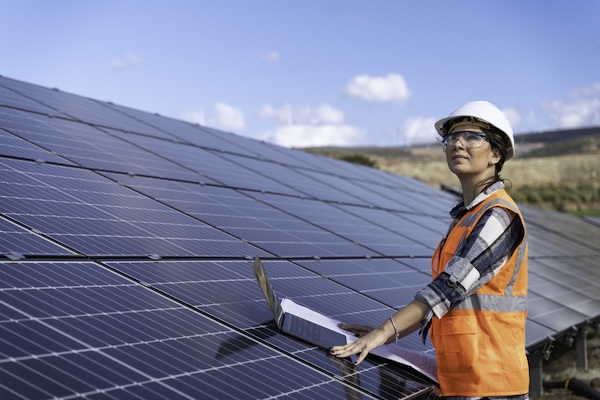
The clean energy economy is here
by Elissa Tennant
The clean energy economy is here, baby, and we’re rolling out the welcome mat. Despite a series of rollbacks under the current administration, this tidal wave can’t be stopped. We’re still seeing a transition to cleaner energy sources in real time that will help us address climate change while remaining competitive with other global superpowers.
This shift toward cleaner energy comes right on time. Americans are facing extreme weather events, like heatwaves and wildfires, exacerbated by a changing climate. We’re also facing a home insurance crisis and rapidly rising electricity bills. Transitioning our energy sources is not only crucial for addressing climate change, it’s a massive economic opportunity.
What is the clean energy economy?
A clean energy economy makes use of renewable energy sources to reduce emissions and boost economic growth. Countries that make a significant investment in clean energy infrastructure are better poised to compete in a global market. Domestically, these countries may also see an increase in job opportunities and cheaper power sources for citizens.
There are many sources of clean energy that make up our energy mix, each of which has its pros and cons. Examples include:
- Solar power: Converts energy from the sun into electricity.
- Wind energy: Converts kinetic energy from blowing winds into electricity.
- Nuclear power: Converts energy from nuclear reactions into electricity.
- Geothermal energy: Converts energy from the Earth’s natural heat into power sources.
- Hydropower energy: Converts kinetic energy from naturally moving water sources into electricity.
- Battery storage: Investment in devices that allow for power generated by the above sources to be stored and used later.
Clean energy setbacks
The United States’ biggest investment in clean energy came in the form of the Inflation Reduction Act of 2022 (IRA). Over its tenure, the IRA spurred hundreds of billions of dollars in clean energy investments and a rapid deployment of projects like solar farms and battery storage facilities.

U.S. clean power generation capacity additions, showing big growth in solar and battery projects since the IRA was passed. Source: American Clean Power
According to an analysis from CCL’s Research Manager, Dana Nuccitelli, investments from the IRA will save about 1 billion tons of carbon dioxide pollution over the next decade. That’s equivalent to permanently shutting down 26 coal power plants, or taking 23 million cars off the road.
Though the One Big Beautiful Bill Act, signed into law July 4, 2025, has ended many clean energy incentives early, it didn’t completely end investments. The administration still supports funding for certain technologies with bipartisan interest, like geothermal and nuclear. The clean energy economy is here, and it doesn’t appear to be making a grand exit any time soon.
How clean energy boosts the U.S. economy
There are several ways in which clean energy investments support a healthy economy:
Job creation
In 2024, a Department of Energy report found that clean energy jobs grew at more than twice the rate of overall employment. In many areas, clean energy jobs have outpaced fossil fuel-related jobs, especially under the IRA. Currently, the five states with the most energy efficient jobs are:
- California (302,176)
- Texas (172,917)
- New York (129,946)
- Florida (125,234)
- Illinois (86,728)
Notably, clean energy requires equipment, including solar panels, wind turbines, batteries, and EV components. The opportunity to fuel the clean energy economy by making these parts in the U.S. provides new manufacturing jobs.
Community development
Clean energy projects are revitalizing communities across the country. The IRA included a landmark Greenhouse Gas Reduction Fund, administered by the EPA, that provided billions in grants for clean energy investments with an emphasis on revitalizing communities “that have historically been left behind.” This funding has since been revoked, but agencies like the Department of Energy and United States Department of Agriculture continue to work with local communities, and especially urban farmers, to spur clean energy investments like solar panels in otherwise unused stretches of land.
Lower energy costs
Without home and building efficiency, air conditioning runs overtime and causes electricity bills to skyrocket. Inflation and regional utility price hikes also contribute to this issue. Switching to cleaner sources of energy provides long-term affordability, giving consumers money back in their pockets.
Energy security & independence
When we continue to invest in oil, we continue to rely on volatile foreign oil markets, subject to shortages, price hikes, and any number of political issues. By investing in clean energy sources domestically, we increase our energy independence. We also promote energy security, reducing the prevalence of power outages and even widespread crises like the Great Texas Freeze.
Climate and public health benefits
The clean energy economy doesn’t just support America’s national wallet. It makes major dents in harmful carbon emissions that fuel climate change.
Switching to clean energy reduces pollution in the air we breathe. It also lowers the risk of harm from heat waves and provides more resilient infrastructure to withstand extreme weather events.
For example: Fossil fuels tend to intensify the urban heat island effect, which states that cities tend to be slightly warmer than surrounding areas. As cities crank their A/C, energy bills rise and residents are subject to peak price hikes and grid failures as fossil fuel-based systems scramble to keep up.
Renewable energy helps decrease the need for polluting peak energy sources during heat waves. Solar panels and energy storage also improve local grid reliability during climate extremes. If we don’t invest in these technologies, we’re stuck with outdated energy sources that ultimately raise global temperatures, making the problem even worse.
What does this mean for everyday Americans?
By investing in clean energy, everyday Americans will see lower utility bills, more local job opportunities, and cleaner air and water. We’ll have more options to live sustainability, from electric vehicles to smart thermostats and clean power providers.
We may have experienced a setback with cuts to the Inflation Reduction Act this year, but the fight isn’t over. We need to continue to support clean energy incentives and tax credits that encourage private investment and innovation.
The clean energy economy isn’t a future vision — it’s happening now, and we can all benefit from embracing it.
How to take action on climate change now
Supporting the clean energy economy means individuals, businesses, and policymakers must collectively come together to form long-term solutions. These long-lasting policies are what will protect the health of our climate for generations to come. Help us get there by taking action today:
 Volunteer for the environment locally
Volunteer for the environment locally
 Electrify your home with clean energy
Electrify your home with clean energy
 Write or Call Congress and let them know you support a national transition to cleaner energy sources
Write or Call Congress and let them know you support a national transition to cleaner energy sources
 Attend one of our climate change conferences this year
Attend one of our climate change conferences this year
 Join one of our weekly Informational Webinars and learn what Citizens’ Climate Lobby is all about
Join one of our weekly Informational Webinars and learn what Citizens’ Climate Lobby is all about
Interested in getting involved? At Citizens’ Climate Lobby, we welcome any and all everyday citizens to join us and thousands of volunteers around the world in our collective goal of climate action.
The post The clean energy economy is here appeared first on Citizens' Climate Lobby.
-
Climate Change2 years ago
Spanish-language misinformation on renewable energy spreads online, report shows
-
Climate Change Videos2 years ago
The toxic gas flares fuelling Nigeria’s climate change – BBC News
-
Climate Change2 months ago
Guest post: Why China is still building new coal – and when it might stop
-

 Greenhouse Gases1 year ago
Greenhouse Gases1 year ago嘉宾来稿:满足中国增长的用电需求 光伏加储能“比新建煤电更实惠”
-

 Climate Change1 year ago
Climate Change1 year ago嘉宾来稿:满足中国增长的用电需求 光伏加储能“比新建煤电更实惠”
-
Greenhouse Gases2 months ago
Guest post: Why China is still building new coal – and when it might stop
-

 Carbon Footprint1 year ago
Carbon Footprint1 year agoUS SEC’s Climate Disclosure Rules Spur Renewed Interest in Carbon Credits
-
Renewable Energy3 months ago
US Grid Strain, Possible Allete Sale


